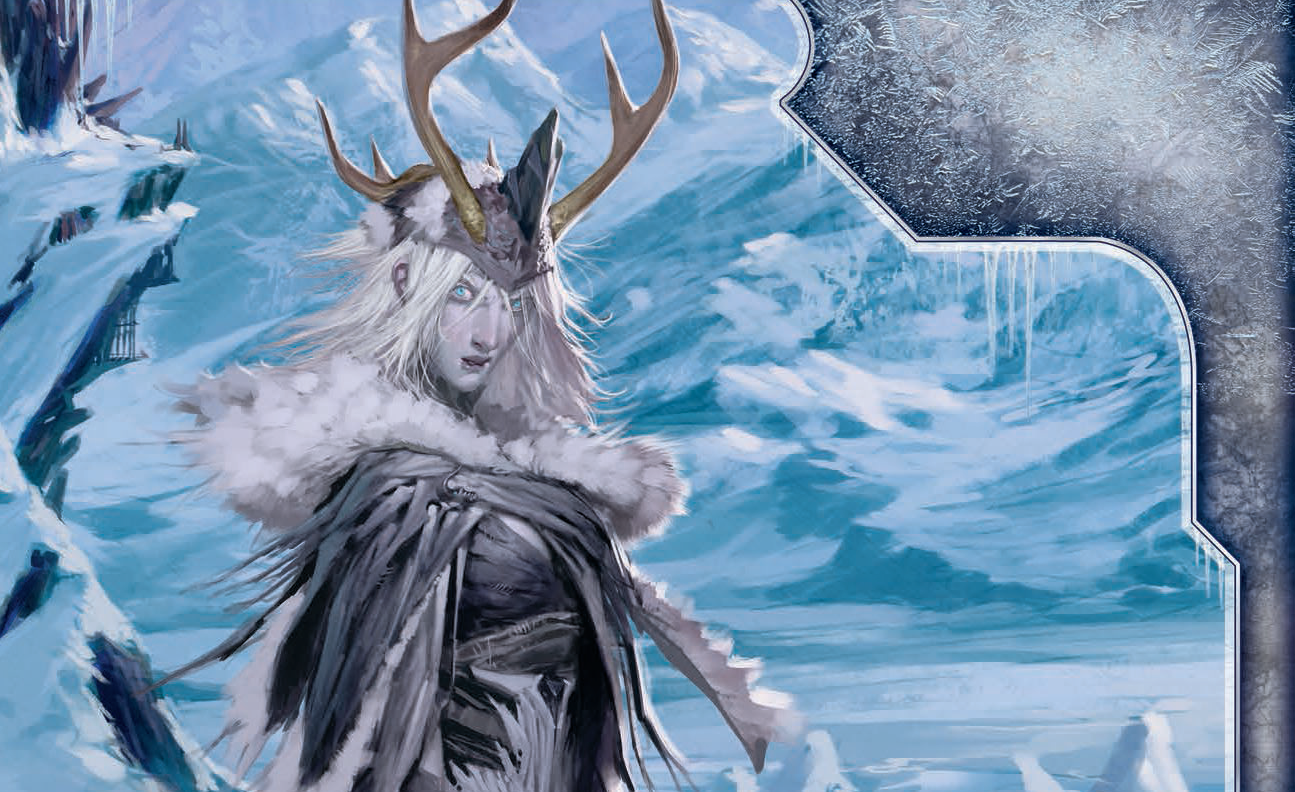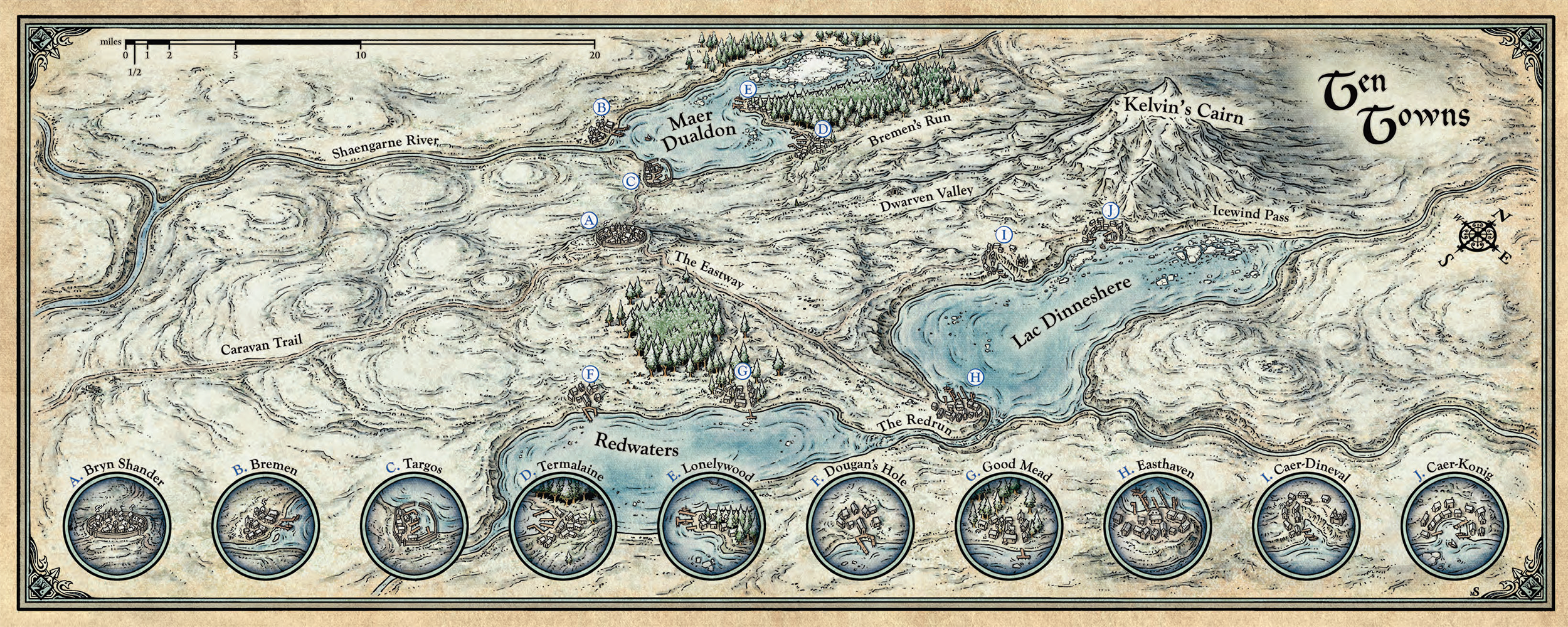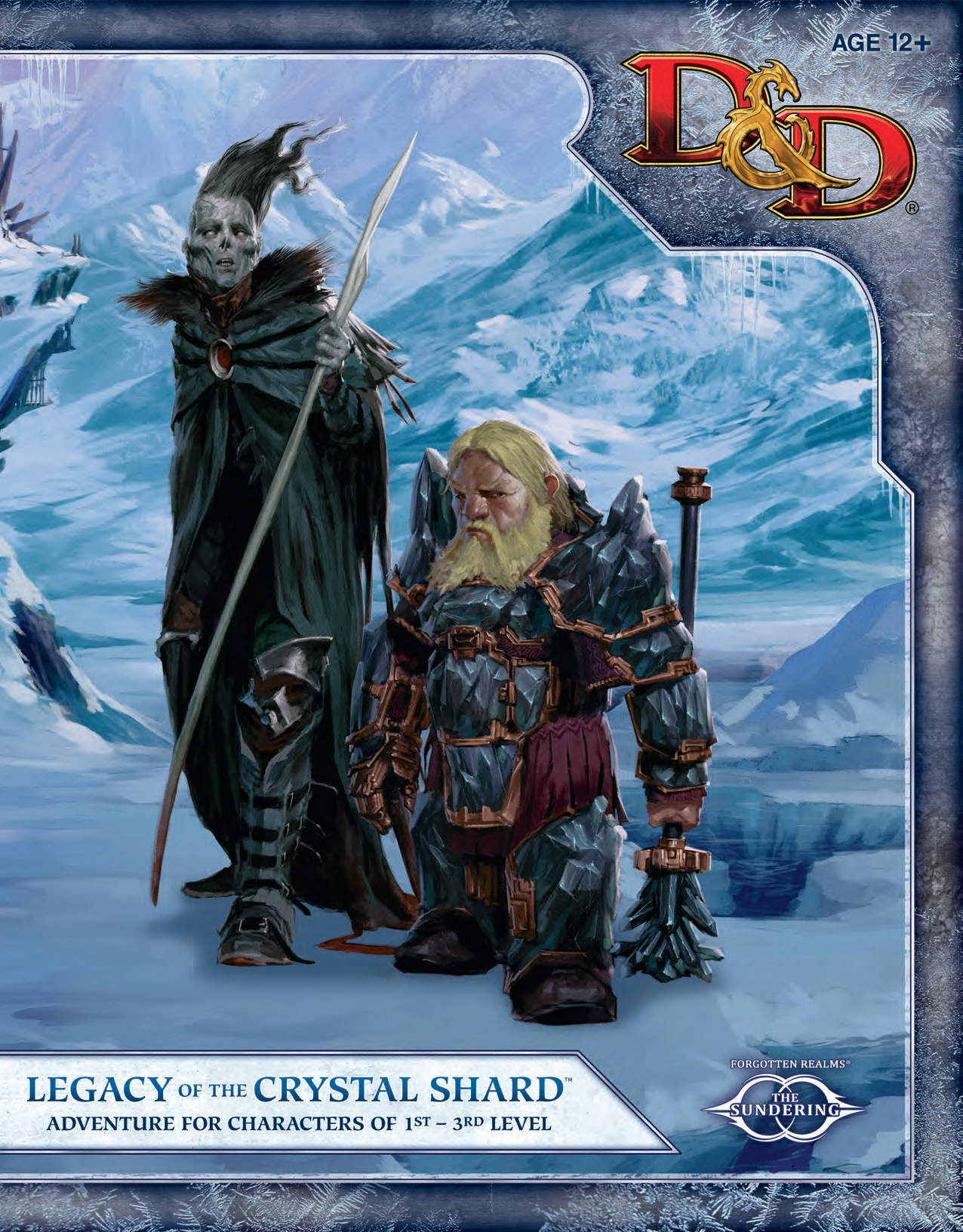Published in 2013, Legacy of the Crystal Shard was created as part of the D&D Next playtest which bridged the 4th Edition and 5th Edition eras. It was designed by R.A. Salvatore with Jeffrey Ludwig, James Wyatt, and Matthew Sernett, and originally sold as a bundle including a 64-page setting book, 32-page adventure book, and four-panel DM screen, supplemented with downloadable PDFs which contained all the stat blocks necessary to run the adventure with 3rd Edition, 4th Edition, or the D&D Next Playtest rules (which are now “close enough” compatible with 5th Edition). It’s now available as a print-on-demand title from the DMs Guild, combining all of these elements plus a micro-prequel adventure that was released during the D&D Encounters Launch Weekend.
I grabbed a copy of Legacy to see if the material could be adapted to flesh out the sandbox of Rime of the Frostmaiden, and this review will be embracing that and, at least in part, assessing Legacy’s value to a Rime DM.
The first thing to note is that large chunks of Rime of the Frostmaiden’s text was actually lifted directly from Legacy of the Crystal Shard. For example, here’s the first couple paragraphs of the “Life Off the Lakes” section of Rime of the Frostmaiden:
Most of the ten towns except Bryn Shander are built on the shores of three big lakes. The largest population of knucklehead trout is in Maer Dualdon, the deepest of the lakes. Redwaters, the shallowest lake, almost completely freezes in winter, making the fishing there difficult. Lac Dinneshere catches the worst of the winds blowing off the Raghed Glacier to the east and thus has the roughest waters. Small thermal vents at the bottom of these lakes keep them from freezing completely, even in the coldest winters.
Ten-Towns fishing boats are simple affairs. The smallest are rowboats and single-masted skiffs that require careful handling to avoid capsizing. Larger, twin-masted cogs and keelboats with single decks handle the wind and waves better. These ships fly the flags of their towns and provide fish for the whole community, not for any individual fisher.
And here’s the “Life Off the Lake” section from Legacy of the Crystal Shard:
Except for Bryn Shander, each of the ten towns is built on the shore of one of the three lakes where knucklehead trout swim, surrounding the mountain of Kelvin’s Cairn. The largest population is in Maer Dualdon, the deepest of the lakes.
Ten-Towns fishing boats are generally simple affairs. The smallest are one-masted skiffs, which are rowed as often as oared – not least because the harsh winds of the dale can capsize each small craft. Larger, two-masted cogs with single decks handle the wind better, and their crews exemplify the neighborly cooperation that makes Ten-Towns function. These ships fly the flags of their towns and provide fish for the whole community, not for any individual fisher.
Rime of a Frostmaiden (1489 DR) canonically takes place a few years after Legacy of the Crystal Shard (1485 DR), so there are a few minor changes. But for the most part, Rime of the Frostmaiden largely assumes that the events of Legacy of the Crystal Shard will have had no meaningful impact on the Dale, and thus large swaths of text are either directly copied or lightly rewritten like a fraternity bro trying to dodge a plagiarism detector.
However, the material in Rime of the Frostmaiden is notably incomplete in several regards. So there’s still value to be had in scooping up the Legacy campaign guide. In particular, Legacy has sizable entries given for the Reghed tribes, Kelvin’s Cairn, the Arcane Brotherhood, and, strangely (given Rime’s titular focus), the worshippers of Auril, the Frostmaiden that are absent from Rime of the Frostmaiden.
THE ADVENTURE
As noted above, the current version of Legacy of the Crystal Shard includes a Launch Day micro-adventure that takes place immediately before the primary adventure kicks off. It takes place while the PCs are traveling to Icewind Dale as part of a caravan, but despite being sixteen pages long, it consists almost entirely of a single, notably overwritten, combat encounter with a crag cat. Its usefulness, therefore, is almost nonexistent.
The primary adventure begins as the PCs’ caravan arrives in Bryn Shander and is ambushed by yetis. This encounter is quite cleverly framed, forcing the PCs to make interesting choices about what to defend and how to strategically split up their efforts.
In the immediate aftermath of the encounter, the PCs are presented with three adventure hooks, each one pointing to a different crisis which is developing in the Dale:
- A member of the Arcane Brotherhood named Vaelish Gant is attempting to establish a mafia in order to seize political power.
- An Ice Witch in the service of the Frostmaiden seeks to bring frozen devastation to the people of Ten-Towns and the Raghed tribes.
- The undead Akar Kessel has escaped from his icy prison and is corrupting the Dale with black ice created from the ruins of the legendary Crystal Shard.
If you’re a long-time reader of the Alexandrian, you might immediately identify that as the textbook introduction to a node-based scenario. Unfortunately, Legacy of the Crystal Shard doesn’t quite follow through on that promise. While the scenario is obviously striving to be open and dynamic, the book struggles to clearly present it as such using largely linear techniques.
You can see this uncertainty and confusion manifest in several ways, but perhaps the most notable is the overall structure of the campaign. In trying to grapple with the diverse and divergent continuities possible with three villainous agendas and PCs free to choose which to confront, Legacy frequently becomes mired in contingency planning, but it crucially attempts to rise about this by implementing two incompatible approaches.
First, there is a timeline of how events will play out unless the PCs get involved. This is a venerable technique, although the execution here is a little problematic: The pace at which things happen on this timeline, combined with the stated travel times in Icewind Dale, makes it exceedingly unlikely that any of the plotted adventure material in the book will be usable as written.
Second, there is an alternative structure in which (a) the PCs get to pursue two of the three threats facing Icewind Dale in Act I and then (b) whichever threat they didn’t deal with advances their schemes in an Interlude before Act II begins. This is another solid way of presenting material like this (particularly in a published adventure), but the specific execution here is once again a little sloppy, with the primary problem being that the continuity of the villains’ schemes in the Interlude don’t consistently carry through into Act II.
The discord between these two approaches combined with the awkward, reflexive use of plotted scenario techniques in an adventure desperately crying out for non-linear design results in a number of weird continuity glitches throughout the text, the most notable of which is almost certainly the rather forced “finale” in which two of the villains are revealed to have been secretly teamed up with each other the whole time in a way which makes absolutely no sense until you realize that they’d probably run out of page count and couldn’t squeeze in a proper conclusion for all three threads of the adventure.
CONCLUSION
Laying all these caveats aside, Legacy of the Crystal Shard is a really good mini-campaign. The three independent crises, mixed with the rich setting of Icewind Dale, creates a really compelling premise, which is then stocked with individual scenarios which are delightfully varied and chock full of vividly creative material: mafioso protection schemes, corrupted ice pirates, undead dragons, dwarven zombies — it’s all the stuff that gets you excited when you think about running it for your players.
If you’re getting ready to run Rime of the Frostmaiden, these scenarios can be almost seamlessly dropped into the campaign, adding some really dynamic elements that will enrich the Icewind Dale sandbox. (The only thing you’ll need to tweak, as far as I can tell, is the “Behind Bars” scenario hook on p. 104 of Rime of the Frostmaiden, which features one of the villains from Legacy of the Crystal Shard. There will almost certainly also be ways in which you’ll want to tie the villains of Legacy to the ongoing events of Rime.)
In short, I recommend Legacy of the Crystal Shard for any D&D fans. And I strongly recommend it for those DMing Rime.
Style: 4
Substance: 4
Author: R.A. Salvatore with Jeffrey Ludwig, James Wyatt, and Matthew Sernett
Publisher: Wizards of the Coast
Cost: $14.99 (PDF) or $19.99 (POD)
Page Count: 112















Any plans on remixing this?
So interesting how similar Legacy and Rime are. I’m running Rime right now and have decided to add more content to the Dwarven Valley based on the Halls of Black Ice encounters in Legacy. I got the idea from u/GenericMantraHere on Reddit who has a really excellent post about fitting the stories together. I highly suggest you check them out!
Mmmm I guess many of the “Next-Era” stuff goes under the radar. I think the only thing adapted for 5E was the “Dead in Thay” adventure that is in that antology book (it’s a megadungeon, neat map).
I’m making a sanbox in Icewind Dale, might be worth giving it a look.
Back in the day, there was a subforum on the Gleemax forums for this module, under the D&D Encounters forum. When those forums were deleted, I saved what I could to ENWorld.
https://www.enworld.org/threads/legacy-of-the-crystal-shard-ultimate-lotcs-resource.469007/
https://www.enworld.org/threads/legacy-of-the-crystal-shard-minis-maps-and-stuff.469003/
That’s a great resource, Liane! Thank you!
I’m DMing Rime and one of my players decided going into the Dwarven Valley. I’m using the Legacy location and including Kessell as a minor BBEG for flavor. From all villains’ plots, it seems the dwarven civil war would be the one more coherent to extend in time, from 1485 to 1489. The party is at levels 4 and 5, so I adapted Kessell as a 4th level wight with many dwarf zombies he created in his lair at the deep mines below Dwarven Valley. It’s my opening quest of Chapter 2.
Is Rime truly a sandbox, or is it a plot driven story game?